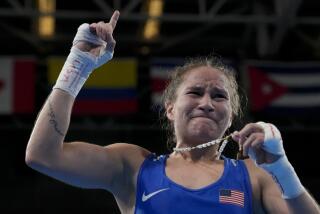Two Goose : Another Wing of the Fighting Goossen Family Takes a Swing at the Big Time
He helped build a boxing business with his bare hands, investing hours of time and buckets of sweat only to take a hike right before his partners struck it rich.
Turning away at the wrong time can cost you. Boxing and gambling have that much in common.
You start pouring your savings into a slot machine, step away for a short break, and someone else saunters up and hits the jackpot.
Pat Goossen has been there, done that. He knows the temptation of wanting to duck your head, tuck your tail and bail out for the duration.
Yet here Goossen is, strutting back into town, acting as confident as a poker player with an ace up his sleeve.
Just maybe that’s exactly what he has.
Pat Goossen never left the boxing game, he just regrouped. Now he’s full-speed ahead again and look who’s leading the charge:
His son.
P.J. Goossen is an unlikely looking warrior, lithe and a bit stoop-shouldered at 5-foot-10, 155 pounds with a shock of blond hair and a deep tan.
But he packs a punch--and a resume.
P.J., 24, has a professional record of 12-0, with 11 of the victories by knockout. On Wednesday, he will box in his first main event, a 10-round superwelterweight bout against a veteran tough named Pat Lawlor in the Warner Center Marriott hotel’s Grand Ballroom.
Lawlor has 20 victories and three of his five losses have come against champions Terry Norris, Hector Camacho and John David Jackson. He has defeated former title-holders Roberto Duran, Wilfred Benitez and Rene Arredondo.
One false move and P.J. might wish he was back stocking shelves as a drugstore clerk.
Pat, 51, who trains and manages his son, has at least as much on the line.
A few months ago, he and his wife, Mona, sold the family’s home of 18 years in Valley Village. They used part of the equity to purchase a home in Palmdale. The rest will help finance a small stable of boxers for what Pat hopes will be a run at boxing fame and fortune.
“I’m gambling that there’s going to be money from boxing coming in the next year,” Pat said.
How’s that for confidence? Pat didn’t just bet the barn. He bet the whole farm.
“I believe in him,” Pat said of his son. “If I didn’t, I wouldn’t be working with him. He believes and I believe.”
Money isn’t the only thing at stake. So is family pride.
Back in the early 1980s, Pat and a younger brother, Dan, organized a family boxing venture. Including brothers, sisters, their father, Al, and mother, Anna May, there were 10 Goossens. And so the Ten Goose Boxing Club was formed on a vacant lot in North Hollywood where a thousand family whiffleball games had been played.
From those humble beginnings emerged the First Family of San Fernando Valley boxing. In the mid-1980s, Ten Goose signed Michael Nunn, an Olympic alternate who climbed through the ranks to become the International Boxing Federation’s middleweight champion.
Ten Goose rose with him--an ascent made without Pat Goossen.
Citing philosophical differences with other family members, Pat, the only Goossen with any real previous boxing experience, walked away from the business just as Nunn was starting to bring the organization some recognition.
Why? “For reasons it would take a paperback novel to explain,” Pat said.
Suffice it to say that Pat feels he has been ostracized by certain members of his family. “There were no crusaders for me (in the Goossen family) once money started coming in,” he said.
Ten Goose went out of business a little more than a year ago when Dan was hired as executive vice president of Top Rank Boxing. But by then the club already had risen to international prominence on the wings of Nunn’s success and that of Gabriel and Rafael Ruelas, brothers who were trained and nurtured by another Goossen brother, Joe.
P.J. made his professional debut in May, 1992, on a Ten Goose-sponsored card at the Country Club in Reseda. However, Pat said, for the most part he and P.J. have been left to fend for themselves.
A 1991 Times story about the rise of Ten Goose mentioned only that Pat was a one-time boxer who was working as a Hollywood stuntman. Accounts in other newspapers and on television have focused on Dan as the founder--a sore subject.
“That’s a bunch of baloney,” P.J. said. “My father was the one who showed them how to throw punches, showed Joe how to do everything. He showed Dan the ropes.”
Dan, 44, acknowledges Pat’s contributions to Ten Goose, adding that he never considered his brother “split from the family.”
It should be noted, however, that Dan isn’t promoting Wednesday’s card, nor has Joe offered to help in P.J.’s corner. Truth be told, it would not be out of the ordinary were both uncles to skip the bouts.
“They don’t have any fighters on the card, so I really don’t expect to see them,” P.J. said. “But if they’re there, I’ll be happy. I still love my uncles. Outside of boxing, we get along well.”
Dan said he will be there, just so long as travel arrangements that will take him to Las Vegas, site of the George Foreman-Michael Moorer title fight scheduled for Nov. 5, don’t interfere.
“I talked to Bob (Arum, president of Top Rank) about P.J. just the other day,” Dan said. “This is the kind of fight that can catapult his career to the next level where we can look at him for our shows.”
The brothers do agree on one thing. A victory over Lawlor would provide P.J.’s career with a big boost.
“He wins this and he’ll be an item,” said Pat, who trains P.J. at the Jet Center, just up the street from the old Ten Goose Gym in Van Nuys.
Said Dan: “It’s the type of fight that separates the men from the boys. Lawlor is in the later stages of his career, but he’s still a good barometer to find out where P.J. is.”
The Lawlor fight is only P.J.’s fourth bout in more than a year, a circumstance he attributes to a lack of willing opponents.
“Good fighters don’t want to risk their record,” P.J. said. “Bad fighters don’t want to be suspended.” As a medical precaution, the state athletic commission prohibits boxers who have been knocked out from returning to the ring for 45 days.
P.J. has more experience as a street fighter than he has in organized competition. He won seven of 10 decisions during a brief amateur career which he braved only as a necessary evil.
“The amateurs are for experience, but they weren’t doing much for me,” P.J. said. “I had more of a pro style. One of my punches make up for about four of somebody else’s.”
As a teen-age street brawler, P.J. spent 14 weeks of his adolescence in a juvenile detention center after a series of probationary infractions followed a conviction of assault and battery in connection with a fight at a skating rink.
Until recently, even in social settings, P.J. was a magnet for trouble. At a party three years ago, he suffered a potentially fatal wound when a man involved in a fight with someone else pulled a knife and stabbed him.
The knife was plunged 3 1/2 inches into P.J.’s chest, narrowly missing his heart and a lung. “They said a centimeter either way and . . . “ P.J. said.
Ringside observers might notice the scar in the middle of P.J.’s chest that serves as a reminder of his tumultuous past. “Now I go to the movies with my wife, and that’s about it,” P.J. said.
That comes as good news for Pat, who had his own professional career cut short by injury. A recurring back problem forced his retirement at the age of 29.
The same congenital defect thwarted Pat’s attempt at a law-enforcement career even before he started to box professionally.
“I pass LAPD medical and this family probably would have been in a whole different direction,” Pat said. “But I’m not sure the city would be any safer.”
Throughout his professional boxing career, Pat said, he was “on automatic pilot.”
His trainer liked to drink when he wasn’t working as night janitor at a department store.
“By the time he got to the gym with me he was so drunk he’d fall asleep,” Pat said. “That was before they had the automatic bell. I would box sometimes what seemed like seven-, eight-, nine-minute rounds before I’d finally turn around and yell, “Bernie!” And he’d wake up from his stupor and yell, “Time!”
Pat’s work as a trainer started in the late 1970s when a friend asked him to tutor young boxers in the Police Athletic League.
Starting Ten Goose a few years later, Pat said, was “something we did to break the boredom of everyday life.”
The club’s original training facility was a makeshift platform built under a tree well within hydrocarbon-whiffing distance of the Ventura Freeway. Instead of rope, the Goossens used discarded garden hoses to form the “ring.”
Ten Goose’s first boxer was Harry (the Fighting Armenian) Kazanbjian, whose contract was bought from his former manager for $100.
“A great deal,” Pat said. “Dan would have paid $200. (Kazanbjian’s manager) wanted $50. They were both happy.”
Almost a decade after leaving Ten Goose, Pat has his own group of boxers, including another of his six sons, 23-year-old Chuck; Chris Sande, a 1988 Olympic bronze medalist from Kenya, and Rocky Pepeli, a heavyweight once managed by Dan.
They, too, are a part of the great gamble. But to a lesser extent.
“Maybe I’m living vicariously through my son,” Pat said, referring to P.J. “But I would love to see him with a (championship) belt around his waist. It would almost be like me wearing it. What could be closer to you yourself doing something than to have your son do it?”
The partnership with his father serves as part of P.J.’s motivation. “I know my dad could make it on his own, but it would be a lot quicker if I helped out a little,” he said.
Though his opponents haven’t been much for quality--anybody ever heard of Adolfo Gasca? Nelson Majia?--11 knockouts in 12 bouts would be a good ratio against cardboard cutouts.
“He’s very athletic and he can whack,” Pat said of P.J. Dan agrees, proving the brothers still share an eye for talent.
Asked if his nephew was a good boxer, Dan replied: “Sure. He’s a Goossen. He’s a fighter.”
More to Read
Go beyond the scoreboard
Get the latest on L.A.'s teams in the daily Sports Report newsletter.
You may occasionally receive promotional content from the Los Angeles Times.











